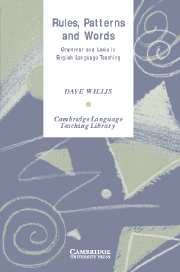Book contents
- Frontmatter
- Contents
- Acknowledgements
- 1 What is taught may not be what is learnt: Some preliminary questions
- 2 Grammar and lexis and learning
- 3 Developing a teaching strategy
- 4 The grammar of structure
- 5 The grammar of orientation: The verb phrase
- 6 Orientation: Organising information
- 7 Lexical phrases and patterns
- 8 Class: The interlevel
- 9 The grammar of spoken English
- 10 A final summary
- References
- Subject index
- Name index
3 - Developing a teaching strategy
Published online by Cambridge University Press: 03 May 2010
- Frontmatter
- Contents
- Acknowledgements
- 1 What is taught may not be what is learnt: Some preliminary questions
- 2 Grammar and lexis and learning
- 3 Developing a teaching strategy
- 4 The grammar of structure
- 5 The grammar of orientation: The verb phrase
- 6 Orientation: Organising information
- 7 Lexical phrases and patterns
- 8 Class: The interlevel
- 9 The grammar of spoken English
- 10 A final summary
- References
- Subject index
- Name index
Summary
In the last chapter we outlined a model to show the relationship between grammar and lexis. As teachers we often see language learning as solving a succession of grammatical problems. We see grammar as coming first and as providing the framework in which lexis can operate. We have to solve the grammatical problems before we can put the vocabulary to work. In theory this is an entirely reasonable way to operate. But as we saw in our discussion in the first chapter things do not seem to work out that way. Learners do not solve one problem, such as the formation of do-questions, incorporate this into their language and then move on to the next stage. They still fail to use do-questions consistently, long after they have worked out the problem of how to produce them consciously.
Since this model does not seem to accord with the way language learning develops, perhaps we should consider another possibility. In Section 1.5 I suggested that learning to use language involves improvisation. In the early stages of learning learners improvise by stringing words and phrases together to communicate. As they learn more and more words the messages they want to communicate become more and more complex. If they are to make their meaning clear, they need to build in more and more the grammar of orientation. And if they want to use language efficiently, they need to build up patterns and phrases which they can call to mind rapidly and spontaneously.
- Type
- Chapter
- Information
- Rules, Patterns and WordsGrammar and Lexis in English Language Teaching, pp. 50 - 68Publisher: Cambridge University PressPrint publication year: 2003

